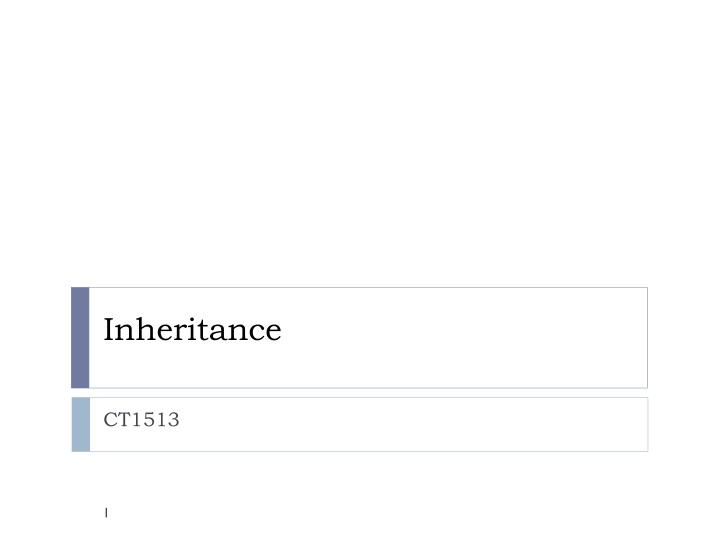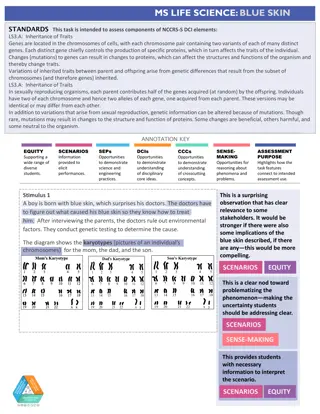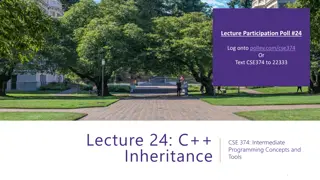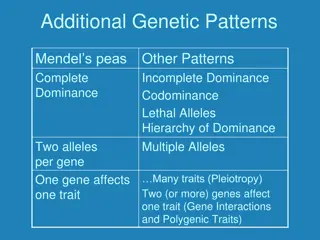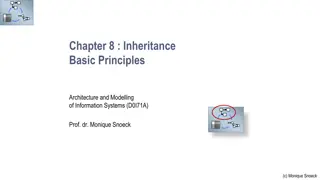Inheritance in Software Development
Explore the concept of inheritance in software development, where new classes can be created from existing ones to enhance reusability. Learn about subclassing, class hierarchy, superclasses, and subclasses, along with examples showcasing this fundamental object-oriented programming concept.
Download Presentation

Please find below an Image/Link to download the presentation.
The content on the website is provided AS IS for your information and personal use only. It may not be sold, licensed, or shared on other websites without obtaining consent from the author.If you encounter any issues during the download, it is possible that the publisher has removed the file from their server.
You are allowed to download the files provided on this website for personal or commercial use, subject to the condition that they are used lawfully. All files are the property of their respective owners.
The content on the website is provided AS IS for your information and personal use only. It may not be sold, licensed, or shared on other websites without obtaining consent from the author.
E N D
Presentation Transcript
Inheritance CT1513 1
Introduction Inheritance Software reusability Create new class from existing class Absorb existing class s data and behaviors Enhance with new capabilities Subclass extends superclass Subclass More specialized group of objects Behaviors inherited from superclass Can customize Additional behaviors 2
Introduction (Cont.) Class hierarchy Direct superclass Inherited explicitly (one level up hierarchy) Indirect superclass Inherited two or more levels up hierarchy Single inheritance Inherits from one superclass Multiple inheritance Inherits from multiple superclasses Java does not support multiple inheritance 3
Superclasses and subclasses Superclasses and subclasses Object of one class is an object of another class Example: mustang is car. Class mustang inherits from class car car: superclass mustang : subclass Superclass typically represents larger set of objects than subclasses Example: superclass: Vehicle Cars, trucks, boats, bicycles, subclass: Car Smaller, more-specific subset of vehicles 4
Examples Superclass Subclasses Student Student GraduateStudent GraduateStudent, UndergraduateStudent UndergraduateStudent Circle, Triangle Triangle, Rectangle Rectangle CarLoan, HomeImprovementLoan HomeImprovementLoan, MortgageLoan MortgageLoan Faculty, Staff Staff BankAccountCheckingAccount CheckingAccount, SavingsAccount Shape Shape Circle Loan Loan CarLoan Employee Employee Faculty BankAccount SavingsAccount 5
Fig. 9.2 | Inheritance hierarchy for university CommunityMembers 6
Modifiers in inheritance Protected (#) makes a data member or method visible and accessible to the instances of the class and the descendant classes (subclasses). Public (+) data members and methods are accessible to everyone. Private(-) data members and methods are accessible only to instances of the class. 8
The derived class inherits all the members and methods that are declared as public or protected. If the members or methods of super class are declared as private then the derived class cannot use them directly. The private members can be accessed only in its own class. Such private members can only be accessed using public or protected getter and setter methods of super class as shown in the example below. 9
Inheritance and Member Accessibility We use the following visual representation of inheritance to illustrate data member accessibility. 10
Accessibility of Super from Sub Everything except the private members of the Super class is visible from a method of the Sub class. 12
Accessibility from Unrelated Class class Super { public int pub_Super_Field; protected int pro_Super_Field; private int pri_Super_Field; public Super () { pub_Super_Field = 10; pro_Super_Field = 20; pri_Super_Field = 30; } } class Sub extends Super { public int pub_Sub_Field; protected int pro_Sub_Field; private int pri_Sub_Field; public Sub () { pub_Sub_Field = 100; pro_Sub_Field = 200; pri_Sub_Field = 300; } } class Client { public void main (String [] args) { Super mySuper = new Super(); Sub mySub = new Sub(); :Super } } int i = mySuper.pub_Super_Field; int j = mySub.pub_Super_Field; // inherited int k = mySub.pub_Sub_Field; VALID :Sub :Client
Accessibility from Unrelated Class class Super { public int pub_Super_Field; protected int pro_Super_Field; private int pri_Super_Field; public Super() { pub_Super_Field = 10; pro_Super_Field = 20; pri_Super_Field = 30; } } class Sub extends Super { public int pub_Sub_Field; protected int pro_Sub_Field; private int pri_Sub_Field; public Sub() { pub_Sub_Field = 100; pro_Sub_Field = 200; pri_Sub_Field = 300; } } class Client { :Super public void main (String [] args) { Super mySuper = new Super(); Sub mySub = new Sub(); } } int l = mySuper.pri_Super_Field; int m = mySub.pri_Sub_Field; int n = mySub.pri_Super_Field; NOT VALID :Sub :Client
Accessibility from Unrelated Class class Super { public int pub_Super_Field; protected int pro_Super_Field; private int pri_Super_Field; public Super() { pub_Super_Field = 10; pro_Super_Field = 20; pri_Super_Field = 30; } } class Sub extends Super { public int pub_Sub_Field; protected int pro_Sub_Field; private int pri_Sub_Field; public Sub() { pub_Sub_Field = 100; pro_Sub_Field = 200; pri_Sub_Field = 300; } } class Client { :Super public void main (String [] args) { Super mySuper = new Super(); Sub mySub = new Sub(); } } int o = mySuper.pro_Super_Field; int p = mySub.pro_Sub_Field; int q = mySub.pro_Super_Field; NOT VALID :Sub :Client
Accessibility of Super from Super class Super { public void superToSuper(Super anotherSuper) { } } int i = anotherSuper.pub_Super_Field; int j = anotherSuper.pro_Super_Field; int k = anotherSuper.pri_Super_Field; VALID anotherSuper :Super :Super
Accessibility of Sub from Sub class Sub extends Super { public void subToSub(Sub anotherSub) { int i = anotherSub.pub_Sub_Field; int j = anotherSub.pro_Sub_Field; int k = anotherSub.pri_Sub_Field; VALID int l = anotherSub.pub_Super_Field; //inherited int m = anotherSub.pro_Super_Field; VALID } } int n = anotherSub.pri_Super_Field; NOT VALID anotherSub :Sub :Sub
Accessibility of Sub from Super class Super { public void superToSub(Sub sub) { int i = sub.pub_Sub_Field; VALID } } int j = sub.pro_Sub_Field; int k = sub.pri_Sub_Field; NOT VALID sub :Sub :Super
Accessibility of Super from Sub class Sub extends Super { public void subToSuper(Super mySuper) { } } int i = mySuper.pub_Super_Field; int j = mySuper.pro_Super_Field; int k = mySuper.pri_Super_Field; VALID NOT VALID mySuper :Super :Sub 4th Ed Chapter 2 - 19
Inheritance and Constructors Unlike members of a superclass, constructors of a superclass are not inherited by its subclasses!! You must define a constructor for a class or use the default constructor added by the compiler. A subclass uses a constructor from the base class to initialize all the data inherited from the base class 21
Inheritance and Constructors In order to invoke a constructor from the base class, it uses a special syntax: public class SubClass extends SuperClass { public SubClass( .) { super ( ); } **the call of the super constructor must be the first statement. Note : if you do not include statement super(). The default constructor of super will be called if any or there will be an error
Inheritance and Method Overriding When we declare the same method in child class which is already present in the parent class the this is called method overriding. In this case when we call the method from child class object, the child class version of the method is called. However we can call the parent class method using super keyword as I have shown in the example below: 23
Using super methods In subclass you can override (or redefine) a method That is already existed in super class. If there is no override you can call a public method of a superclass by its name and appropriate parameter list. If the sub override the super method you should call it by using the reserved key word super.methodsName()
Defining Classes with Inheritance Case Study 1: Suppose we want implement a class Employee which has two attributes, id and name, and some basic get- and set- methods for the attributes. We want now define a PartTimeEmployee class; this class will inherit these attributes and methods, but can also have attributes (hourlyPay) and methods of its own (calculateWeeklyPay). 26
Not valid No call | super();
Defining Classes with Inheritance-Protected Modifier 31
Implementation of the case study public void setNumber(String N) public class Employee { {number=new String(N);} protected String number; }//end class protected String name; public Employee (String N, String E) { number = N; name = E; } public String getNumber() { return number;} public String getName(){return Name;} public void setName(String N) {name=new String(N);} 32
Implementation of the case study public double calculateWeeklyPay(int c) { return hourlyPay * c; } } // end class public class PartTimeEmployee extends Employee { private double hourlyPay; public PartTimeEmployee(String N,String E,double H) { super(N,E); hourlyPay=H; } public void setHourlyPay(double H) {hourlyPay=H;} public double getHourlyPay(){return hourlyPay;} } 33
Implementation of the case study System.out.print ( Hourly pay? ); pay = input.nextDouble(); System.out.print ( Hours worked this week? ); hours = input.nextInt(); // create a new part-time employee emp = new PartTimeEmployee (number, name, pay); //display employee s details, including the weekly pay System.out.println(); System.out.println(emp.getName()); System.out.println(emp.getNumber()); System.out.println(emp.calculateWeeklyP ay(hours)); } import java.util.Scanner; public class PartTimeEmployeeTest { public static void main(String[] args) { Scanner input = new Scanner(System.in); String number, name; double pay; int hours; PartTimeEmployee emp; // get the details from the user System.out.print ( Employee Number? ); number = input.next(); System.out.print ( Employee Name? ); name = input.next(); } i 34
public class rectangle { private double length; private double width; } //defoult constructor public rectangle() {length=width=0; } public rectangle( double w , double l){ setdimension(w,l); } public void setdimension( double w, double l){width=w; length=l; public double getw(){return width;} public double getl(){return length;} public double area(){ return width*length;} public void print() {System.out.println("length =" + length+"width = " + width );} }
Create class called box inherits from rectangle having the following: Private height ,, ge_height() Default constructor and copy constructor to set Setdimension(); Area();//2*L*W + L * H +W* H Print();
